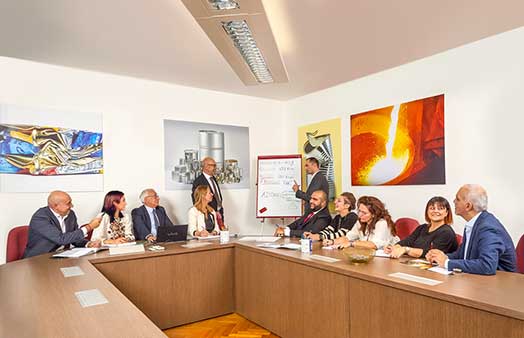As one of the most widespread materials in the world, second only to concrete, steel is used in all economic and production sectors: in industry, electronics, mechanics, construction, goods and objects of daily use, and in packaging.
Since the origins of our industrial society, steel has occupied a prominent place, so much so that the beginning of the industrial era is often made to coincide with the appearance of large steel production units.
Steel has played and still plays a major role in the technological evolution of humanity, thanks to its high resistance properties (to pressure, high temperatures, atmospheric agents, corrosive agents). A second feature of steel is ductility, i.e. the ability of a steel component to undergo a “plastic” deformation before breaking.
The strength and ductility of steel mean it can be used in the most varied applications.
The level of strength and ductility vary in each specific steel alloy, and their different combinations determine which steel type is chosen according to the intended use.
Dissemination and use
Applications
The main sectors steel is used in are presented below.
Construction and infrastructure
In recent decades, with the diffusion of vertical architectures and the construction of large works, such as increasingly modern and spectacular bridges and viaducts, steel has become a material of primary importance in the construction industry thanks to its resistance to stress and atmospheric agents. Modern tensile structure constructions are an example of how flexibility, lightness, resistance to stress and temperatures make it possible to create otherwise impossible works. Even from an aesthetic point of view, contemporary architecture prefers steel, allowing the creation of ever lighter and more spectacular structures.
Transport
Steel occupies a prominent position in the railway industry (both in the production of trains and rails) and in the shipbuilding and aeronautics sectors. In the automotive sector, it is still by far the most used material, accounting on average for between 50% and 70% of a car’s weight.
Extraction and distribution of hydrocarbons
Steel is used for the construction of platforms and drills in extraction plants, often in difficult environmental situations, where high temperatures and strong pressures require reliable and safe solutions.
The field of oil extraction is an exceptional testing ground for the development and production of complex steels that can withstand the most extreme stresses.
Steel is used in the construction of oil and gas pipelines for the distribution of hydrocarbons.
Chemical and petrochemical industry
In chemical and petrochemical plants, steel is used in the construction of pipes capable of resisting not only the corrosive action of the processed fluids but also particularly high temperature and pressure conditions.
Power plants
Inside the plants for the production of electricity, all the main components are made of steel: boilers (whose main components are seamless steel pipes resistant to sliding, thermal, mechanical and corrosive stress), turbines (made with differentiated steels, to specifically resist high temperatures and wear in moving parts), and condensers (made of stainless steels to limit corrosion phenomena).
Appliances and sanitary ware
Stainless steel laminates are a semi-finished product used in the household appliance sector for the production of large household appliances (refrigerators, washing machines, dishwashers, air conditioners, etc.), components (electric motors, compressors for refrigerators and air conditioners), and sanitary ware (bathtubs, showers, water heaters etc.).
Containers and packaging
In the food preservation sector, steel guarantees a high level of hygiene and resistance to bacteria, and is widely used in the production of containers for long-life products. Its resistance to corrosion makes it the ideal material for the construction of tins and drums for varnishes, paints and other chemical products.
Mechanical and manufacturing industry
Gears, shafts, bearings, cylinders, moulds, shears, punches, saws and tools of all kinds are made of steel, as are the components of machinery for every industrial sector.



